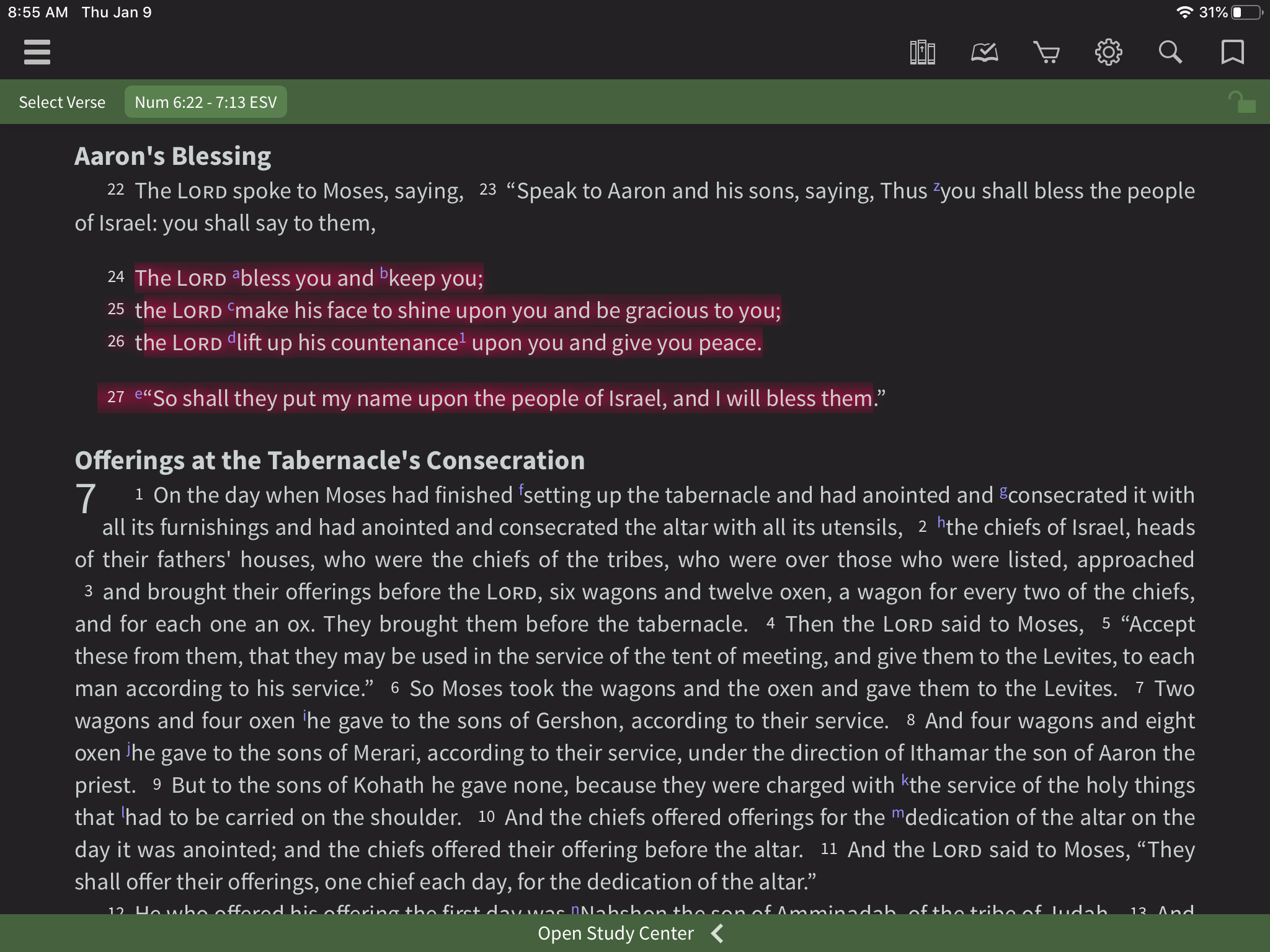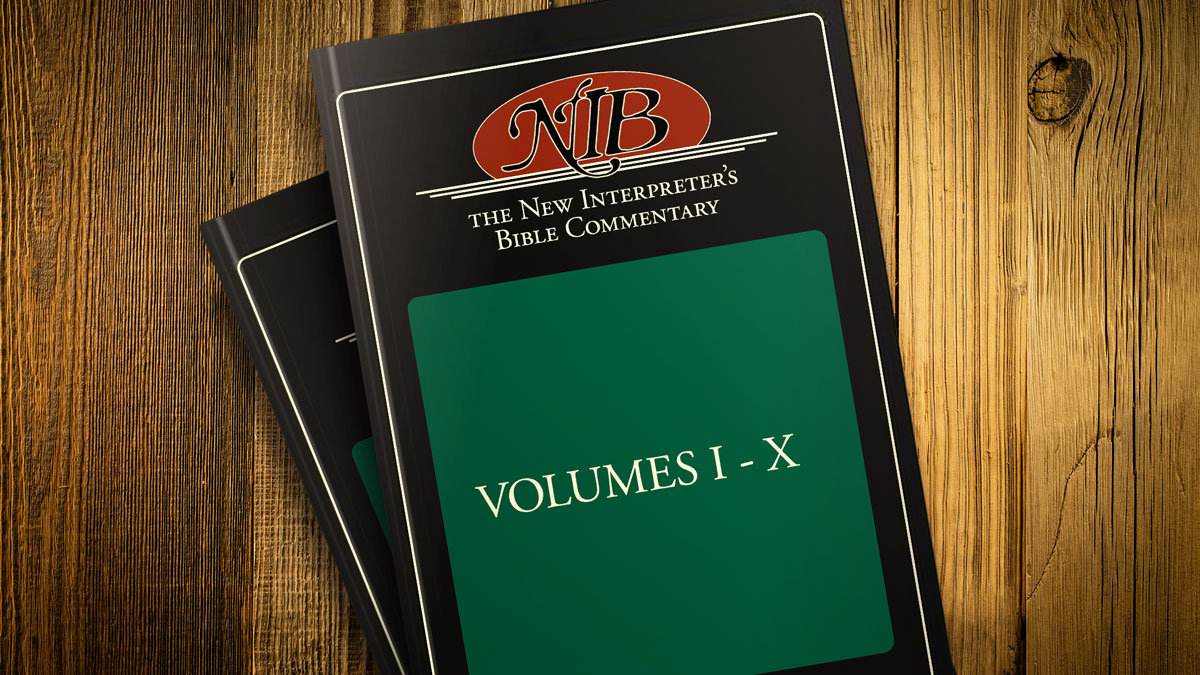You’ve probably heard the priestly blessing at least once or twice: “the Lord bless you and keep you”. Maybe you heard it without realizing what it was. Or, perhaps you have been dying to learn more about this passage, the Aaronic blessing, in Numbers. Either way, this article is for you. Taken from the New Interpreter’s Bible Commentary, it is some great information.
The Lord said to Moses, “Tell Aaron and his sons,
‘This is how you are to bless the Israelites. Say to them:
‘The Lord bless you
and keep you;
the Lord make his face shine on you
and be gracious to you;
the Lord turn his face toward you
and give you peace.’
‘So they will put my name on the Israelites, and I will bless them.’”
Numbers 6:22-27 (NIV)
Blessing Rooted In Israelite Culture
The act of blessing is deeply rooted in Israelite culture. It bears a wide range of meaning. On the one hand, Jacob’s stealing of Esau’s blessing and the latter’s inability to acquire another from his father, Isaac (Gen 27:30-38), provides a glimpse into the near magical power of blessing. In that story, to bless is to bestow power for fertility and well-being, which, once spoken, takes on a life of its own. On the other hand, the expression of divine blessing appears to be no more than a stereotypical exchange for “Hello.” The book of Ruth provides an example of how the invocation of divine blessing was part of the everyday language of greeting, for example, when the harvesters welcome Boaz with the words, “The Lord bless you” (Ruth 2:4).
The cultic use of divine blessing, as in vv. 24-26, functions someplace between the two examples noted above.
The cultic use of the priestly blessing was widespread by the late monarchical period. Similar cultic language is richly attested in other liturgical literature. Psalm 129:8, for example, concludes with a priestly blessing on the worshipers, “The blessing of the Lord be upon you. We bless you in the name of the Lord” (see also Pss 128:5; 133:3; 134:3).
The Hebrew inscription “the Lord bless you and keep you and be with you” was found on a jar at Kuntillet ‘Ajrud in the upper Sinai, dating from the eighth-century. This inscription indicates the use of a blessing very similar to the Aaronic blessing in Num 5:24-26, already in the middle of the monarchical period. The discovery of the priestly blessing in a burial cave in the area of Jerusalem known as the Valley of Hinnom (contemporary Keteph Hinnom) is even more striking. The blessing is written on two silver amulets that date from the late seventh century.
An amulet is an object believed to give magical powers of protection against evil to the one who wears it. The discovery of such an amulet in a grave raises further questions of whether the priestly blessing was meant to function in association with the dead. Baruch Levine suggests that the priestly blessing may have protected the dead on their way to Sheol.
The Blessing’s Structure
The priestly blessing has a simple structure, consisting of three lines, each of which contains two verbs: bless-keep (protect), shine-grace, lift-peace. The name “Yahweh” appears once in each line, in association with the first of the paired verbs.
Yahweh bless you and keep you;
Yahweh make his face to shine upon
you and be gracious to you;
Yahweh lift up his countenance upon you—
and give you peace

Two readings are possible from this structure.
The six verbs could be interpreted to describe distinct actions of God. They can also be interpreted in pairs. The first verb in each line summarizes an activity of God upon the worshiper, and the second describes the results of God’s actions. The use of the name “Yahweh” as the subject for only the first verb in each sentence favors the interpretation in which the verbs are paired. The result is a threefold blessing.
The first emphasizes concrete gifts—blessing and security (guarding).
The second stresses the hope that God will be well disposed toward the person (to lighten or shine upon the worshiper) and thus temper judgment with mercy (to be gracious).
The third asserts that God will pay attention (lift his face), thus providing fullness of life (peace). David Noel Freedman notes a variety of subtle stylistic devices in the Hebrew that aid in carrying out the meaning of the priestly blessing. These include a progression in the numbers of words (3, 5, 7) and consonants (15, 20, 25) in each line. The progression is framed by an opening (“The Lord bless you”) and a closing (“and give you peace”) cola of the same length (7 syllables in Hebrew).
Blessing Within the Context
Numbers 6:22-23, 27 frames the priestly, Aaronic blessing within the context of Numbers 5–6. These verses take the form of divine instruction for the Aaronide priesthood. Numbers 6:22-23 indicate that the Aaronic blessing is meant to function as a concluding benediction (vv. 22-23) to the instruction for camp purity in chaps. 5–6. Numbers 6:27 clarifies that it is God (rather than the priests) who blesses Israel.
The literary setting has puzzled scholars, prompting some even to suggest that the text has been displaced from Lev 9:22, where Aaron is also described as blessing the people from the door of the tent of meeting. But the function of the Aaronic blessing as a concluding benediction on the camp and the congregation does correspond to other cultic uses of the priestly blessing in the Psalms (e.g., Psalm 129:1), suggesting that its present context is less arbitrary than many have suspected.
The overall design of Numbers 5–6 provides additional guidelines for interpreting the priestly blessing in its present context.
The placement of the priestly benediction at the door of the tent of meeting follows naturally upon the inward movement of the laws of defilement. These laws began with contamination requiring expulsion from the camp (5:1-4), followed by three types of relationships within the camp with the power to defile. These relationships moved in an ever-closer orbit to the tabernacle at the center of the camp—from defrauding in general (5:5-10), to adultery (5:11-31), and through to the Nazirite vow (6:1-21). The location for expiatory rituals has tended to follow the same movement. The laws of defrauding and adultery require that the offender be presented “to the priest” (5:9, 15), while the defiled Nazirite must go “to the door of the tent of meeting” (6:10, 13). The door of the tent of meeting is also the location for the priestly blessing on the congregation (see Lev 9:22).
The priestly blessing has at least two functions in its present literary context.
It provides yet another safeguard against defilement by blanketing the camp with the power of divine blessing. It also concludes Numbers 5–6 with a description of the ideal camp. The ideal is where God pays particular attention to persons, where blessing and security drive out the power of death, and where the achievement of wholeness and peace is possible.
The Central Message of Blessing
The priestly blessing (Num 6:22-24) is the most familiar passage in Numbers 5-6. The central message of the blessing is stated in the closing Hebrew word, שׁלום (šālôm), translated “peace”. In English, “peace” connotes the absence of war. It can also describe a state of tranquility. These meanings are also in the Hebrew. But the peace of God in the priestly blessing embraces even more aspects of life. It includes good health, security, inner harmony, wellness, material prosperity, and a long life. The broad and rich meaning of “peace” in the priestly blessing reinforces the role of holiness in the life of Israel. It brings about both social and physical health.
It is noted in the Commentary that the Aaronic blessing provides an ideal vision of the camp. Also, it functions as a conclusion to the laws of defilement in Numbers 5–6. The ideal of the priestly blessing continues in contemporary Jewish and Christian worship. It is included in most lectionary cycles as a topic for preaching. The blessing of God also continues to be the last word in many of our Sunday liturgies as a closing benediction.
The central task in preaching this text is to explore what blessing means.
Is the bestowal of a blessing sacramental, or is it no more than a socially polite activity? Also, what is it that we receive at the close of a worship service? Is real divine power transmitted in blessing? Or, is the preacher simply telling us that the worship service is nearly over? The latter point creates a problem for interpreting the priestly benediction. Notice how the introduction to the priestly blessing (Num 6:22-23) stresses that only priests can bless. It is not a casual activity. Additionally, the conclusion (Num 6:27) indicates how close the text is to the world of magic. The author must clarify that the priest does not possess the power to bless independently of God. The need for such clarification underscores that divine blessing has independent power that can be let loose in the congregation.
New Interpreter’s Bible Commentary

This excerpt on the Aaronic blessing is adapted from the New Interpreter’s Bible Commentary (10 Vols.). This series offers critically sound biblical interpretations. Also, it is written by scholars, pastors and laity representing diverse traditions and academic experience. Therefore, this collection of commentary meets the needs of preachers, teachers, and all students of the Bible.




0 Comments